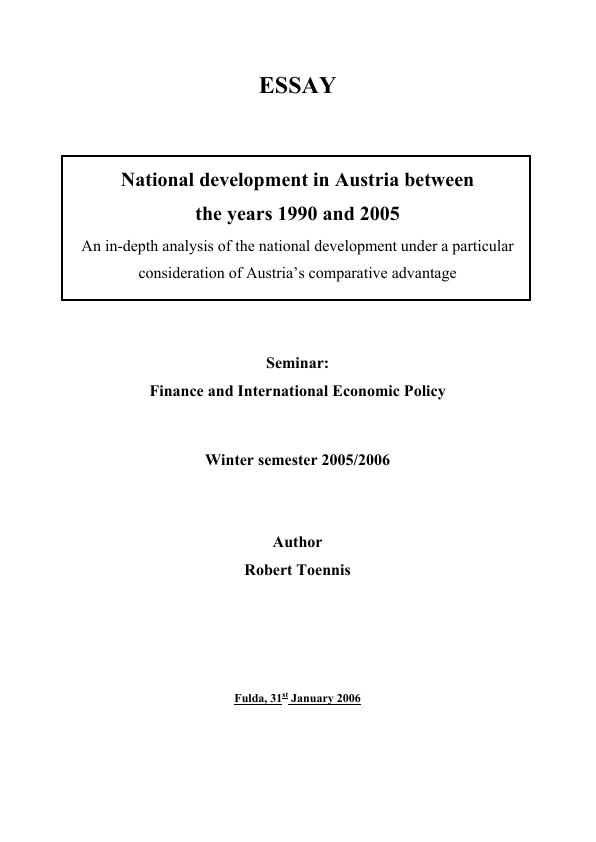The following essay presents an overview of the national development in Austria between the years 1990 and 2005 with a special emphasis of the last five years. Concerning the wideness of the topic, this essay only deals just with selected points.
1. Basic data′s about Austria
2. Austrian′s comparative advantage
3. Foreign trade
4. Direct and portfolio investments
5. Advantages and disadvantages as a result of foreign trade
According to the importance of exports and imports of goods, services, capital and know-how - especially for a small and open national economy like Austria - this essay will implicitly point out Austrian′s comparative advantage, including the mentioned points on top (three till five).The very fact that every third job is dependent of Austrians export makes the relevance of Austria′s comparative advantage in this context clear.
Table of Content
Executive Summary
1) Austria – some basics
2) Austria’s comparative Advantage
3) Foreign Trade
4) Direct and Portfolio Investment
Direct investments in international comparison
5) Advantages and disadvantages as a result of foreign trade – under consideration of the regional trade agreement EU
6) List of literature
Executive Summary
The following essay presents an overview of the national development in Austria between the years 1990 and 2005 with a special emphasis of the last five years. Concerning the wideness of the topic, this essay only deals just with selected points.
1. Basic data’s about Austria
2. Austrian’s comparative advantage
3. Foreign trade
4. Direct and portfolio investments
5. Advantages and disadvantages as a result of foreign trade
According to the importance of exports and imports of goods, services, capital and know-how - especially for a small and open national economy like Austria – this essay will implicitly point out Austrian’s comparative advantage, including the mentioned points on top (three till five).The very fact that every third job is dependent of Austrians export makes the relevance of Austria’s comparative advantage in this context clear.
1) Austria – some basics
Austria is located in central Europe and has a population of 8.032.926 in 2001. (source: Statistik Austria, p. 46, Wien, 2006).
illustration not visible in this excerpt
Fig. 1: “Gross Domestic Product”, source: Statistik Austria, p. 308-309, Wien, 2006
According to figure 1, its Gross Domestic Income (GDP) amounted 237.039million € in 2004. This represents an increase of 74% from 1990 - when the GDP was just 136.326million € - to the year 2004.
The most imported goods concerning quantity were raw materials including electricity (460.096.614 in 100kg) in 2002. Simultaneously, the most exported goods were also raw materials including electricity (139.806.563 in 100kg). Regarding the value, the most imported goods were finished goods (53.981.263.000€) in 2002. Simultaneously, the most exported goods regarding the value were also finished goods (58.534.174.000€) (source: Statistik Austria, p. 398-399, Wien, 2006).
Apparently, the most imported goods concerning quantity are higher by almost three times than exports, but concerning the value, the most exported goods are higher by 8,43% than imports. This evaluation indicates explicitly that the quantity of goods increased and as well as the amount of money in circulation within Austria.
2) Austria’s comparative Advantage
Definition comparative advantage: “the advantage in the production of a product enjoyed by one country over another when that product can be produced at lower cost in terms of other goods than it could be in the other country” (source: Krugman/Obstfeld, Boston, 2003).
This generally accepted definition is often regarded to manufactured products. Apart from that, a country can also have a comparative advantage in services as long as exports are higher than imports. Austria is such a country because as we can see in figure 2 a comparative advantage in tourism is occurred. From 1990 till 2004 exports were higher than imports steadily, implying that the foreign tourists spent more money in Austria (11.287million € in 1990 and 14.886million € in 2004 went into the country) on the other side, Austrians spent outside the country for their trips to other countries (5.355million € in 1990 and 8.428million € went out of Austria).
illustration not visible in this excerpt
Fig. 2: “Foreign Trade”, source: Statistik Austria, p. 316, Wien, 2006
To quantify the comparative advantage and analyze its importance for Austria, it is necessary to measure the monetary dimension of the tourism sector. In order to assess this we will look at figures from the “Tourism-Satellite-Account for Austria” (source: Franz/Laimer/Smeral, Wien, 2001).
illustration not visible in this excerpt
Fig. 3: “Overnight stays 2001-2004 in collective tourist accommodations”, source: Statistik Austria, Wien, 2006
Figure 2 shows “Overnight stays 2001-2004 in collective tourist accommodations”, Austria has shown the highest tourism intensity and it increased steadily from 11,4% in 2001 up to 11,7% in 2004. The share of foreigner was 71,1% in 2001 and rose up to 71,7% in 2004. If we consider the importance of Austrians export (what we already mentioned at the beginning of this essay) we see the dependency of Austria’s export especially of the sector tourism. Figure 4 will illustrate this even more in detail because the share of tourism to the GDP was 16,5% in 2004. Moreover, the share of foreigner is an indicator for Austria’s popularity as a vacation land in Europe.
[...]
- Citation du texte
- Robert Tönnis (Auteur), 2006, National development in Austria between the years 1990 and 2005, Munich, GRIN Verlag, https://www.grin.com/document/67135
-

-

-

-
Téléchargez vos propres textes! Gagnez de l'argent et un iPhone X. -

-
Téléchargez vos propres textes! Gagnez de l'argent et un iPhone X.

